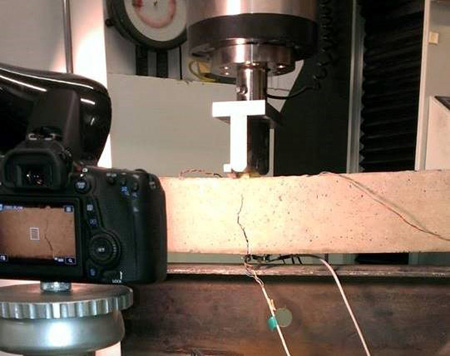Reinforced concrete crack analysis

Due to rapid advances in the development of techniques for monitoring and retrofitting concrete, there is a need to revisit and generalise classical theories in order to better assess the strength of existing reinforced concrete (RC) structures and to inform the design of strengthening systems. An improved understanding of concrete cracking is an implicit requirement to achieve these aims. Cracking is a major deterioration mechanism when considering the durability and service life of concrete and it involves diverse phenomena such as the formation of cracks, crack propagation, the existence of micro-cracks, interactions between the reinforcement and the concrete, and the concrete microstructure. Over the past decades various models were developed to simulate the cracking process in reinforced concrete beams. These models can broadly be classified as plasticity based models which are justified in the case of ductile behaviour e.g. beams with sufficient internal steel, and fracture mechanics based models which do not treat fracture as a point phenomenon but use fracture mechanics principles to explain the crack propagation. This research seeks to identify the criteria that relates to the transition between these two perspectives and to generalize the modelling of the cracking process to explicitly include different reinforced concrete parameters.
Selected references
| Augusthus-Nelson L, Lees JM and Weekes L. (2021) Size effects in unreinforced and lightly reinforced concrete beams failing in flexure, Engineering Fracture Mechanics. https://doi.org/10.1016/j.engfracmech.2021.107987 |
| Fayyad, T.M. and Lees, J.M. (2018) "Integrated fracture-based model formulation for RC crack analysis". ASCE Journal of Structural Engineering, 144(7). (accepted version) (doi) |
|
Fayyad, T.M. and Lees, J.M. (2017) "Experimental investigation of crack propagation and crack branching in lightly reinforced concrete beams using digital image correlation". Engineering Fracture Mechanics, 182:487-505 (accepted version) (doi) |
| Fayyad, T.M. and Lees, J.M. (2014) "Application of Digital Image Correlation to Reinforced Concrete Fracture" Procedia Materials Science - 20th European Conference on Fracture, Eds Z. Zhang, B. Skallerud, C. Thaulow, E. Østby and J. He, Elsevier v. 3 , pp. 1585–1590 (published copy)(doi) |

